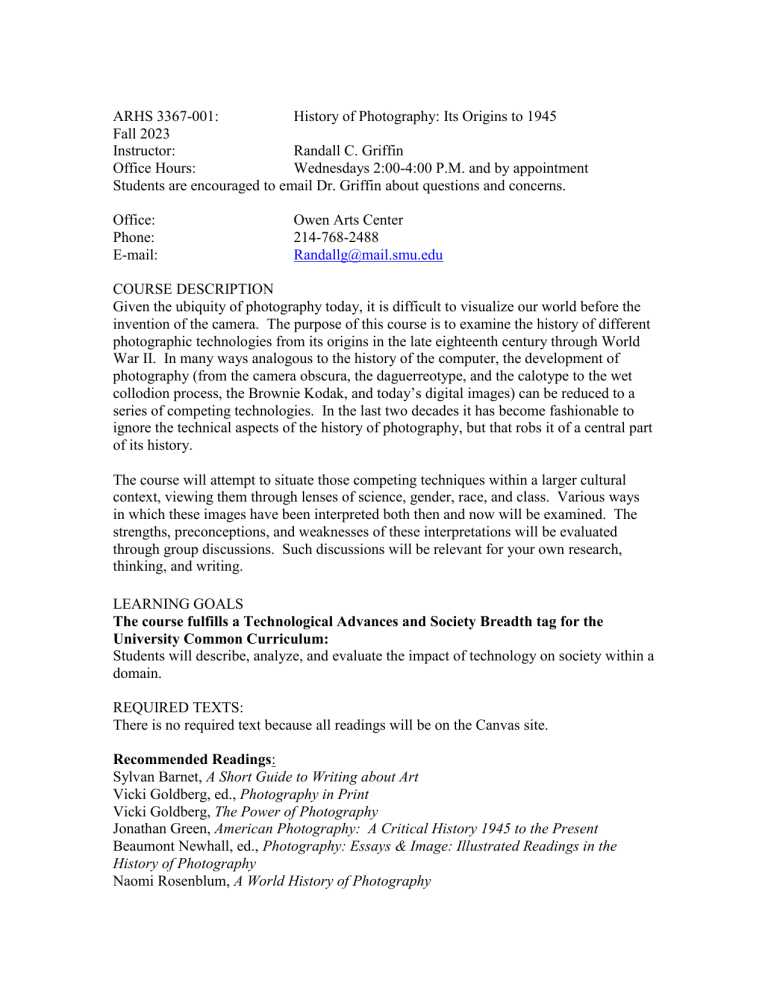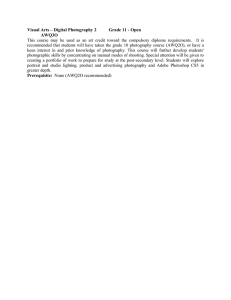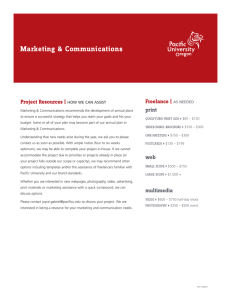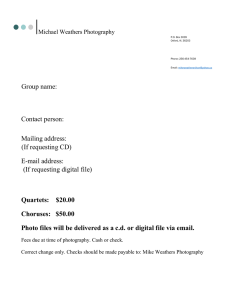
ARHS 3367-001: History of Photography: Its Origins to 1945 Fall 2023 Instructor: Randall C. Griffin Office Hours: Wednesdays 2:00-4:00 P.M. and by appointment Students are encouraged to email Dr. Griffin about questions and concerns. Office: Phone: E-mail: Owen Arts Center 214-768-2488 Randallg@mail.smu.edu COURSE DESCRIPTION Given the ubiquity of photography today, it is difficult to visualize our world before the invention of the camera. The purpose of this course is to examine the history of different photographic technologies from its origins in the late eighteenth century through World War II. In many ways analogous to the history of the computer, the development of photography (from the camera obscura, the daguerreotype, and the calotype to the wet collodion process, the Brownie Kodak, and today’s digital images) can be reduced to a series of competing technologies. In the last two decades it has become fashionable to ignore the technical aspects of the history of photography, but that robs it of a central part of its history. The course will attempt to situate those competing techniques within a larger cultural context, viewing them through lenses of science, gender, race, and class. Various ways in which these images have been interpreted both then and now will be examined. The strengths, preconceptions, and weaknesses of these interpretations will be evaluated through group discussions. Such discussions will be relevant for your own research, thinking, and writing. LEARNING GOALS The course fulfills a Technological Advances and Society Breadth tag for the University Common Curriculum: Students will describe, analyze, and evaluate the impact of technology on society within a domain. REQUIRED TEXTS: There is no required text because all readings will be on the Canvas site. Recommended Readings: Sylvan Barnet, A Short Guide to Writing about Art Vicki Goldberg, ed., Photography in Print Vicki Goldberg, The Power of Photography Jonathan Green, American Photography: A Critical History 1945 to the Present Beaumont Newhall, ed., Photography: Essays & Image: Illustrated Readings in the History of Photography Naomi Rosenblum, A World History of Photography Martha Sandweiss, ed., Photography in Nineteenth-Century America Aaron Scharf, Art and Photography Susan Sontag, On Photography John Szarkowski, The Photographer’s Eye Alan Trachtenberg, Reading American Photographs: Images as History COURSE REQUIREMENTS: Quizzes on readings or lectures If a student fails or misses three quizzes (unless they have a documented health or family emergency), he/she will drop a letter grade in the final course grade. First Paper 10% of grade Due October 18 Second Paper 10% of grade Due November 6 Exam 1 40% of grade October 6 Final Exam 40% of grade Thursday, December 8 (8:00-11:00 a.m.) Grading Dr. Griffin will be doing all of the grading of the quizzes, papers, and exams. All of the quizzes, papers, and exams will have an answer key. Feedback will be supplied about points missed. Grading scale: F: 59 or below D-: 60-63 D: 64-66 D+: 67-69 C-: 70-73 C: 74-76 C+: 77-79 B-: 80-83 B: 84-86 B+: 87-89 A-: 90-93 A: 94-96 A+: 97-100 Extra credits: During the semester, students will be offered 6 extra credits. These are only mentioned in lecture. Students have to do 3 extra credits in order to raise their grade by 1/3 of a letter grade. Quizzes: Quizzes will be announced in lecture a week before they take place. Students are expected to take detailed notes about the assigned reading or lecture, and are encouraged to refer to their notes during the quiz. Quizzes will consist of three questions and are pass/fail: students need to get two of the answers right to pass. If a student misses (without proper documented excuse) or fails three or more quizzes, their final course grade will be lowered by one letter grade. Conversely, if a student passes all of the quizzes, it will raise their course grade by 1/3 of a letter, say from a B+ to an A-. Exams: Each exam will consist of three parts: 1) The first section will be composed of five slide identifications. You will be asked to identify the images by providing the artist’s name, along with the name and date of the work, and the location for buildings. The date must be within five years of the date provided on the slide sheet (handed out one week prior to each exam). The images will also be available at that time on Blackboard. All names and titles should be spelled correctly. You will have one minute per slide. This section is worth twenty points. For extra credit (two points), in one minute, you will be asked to identify by artist and date (within twenty five years) a work of art not previously shown in class. 2) The second part of each exam will consist of a fifteen-minute essay question concerning a work of art that is listed on the slide sheet. This section is worth forty points. 3) The third part of each exam will consist of one twenty-minute slide comparison. After providing the same information required for the slide identifications, students will be asked to compare and contrast the two works of art. This section is worth forty points. Exams will not be cumulative. No examination makeups will be allowed without documentation of a medical or family emergency. Students must follow SMU’s Honor Code. Students with learning disabilities should bring a letter verifying that they have been tested by SMU officials, and then discuss the exam procedures with the instructor. Possible Paper Topics Students must select one of these five photographs for both of their papers. John Edwin Mayall, The Crystal Palace, London, During the Great Exhibition of Works of Industry of All Nations, 1851, a daguerreotype William Henry Jackson, The Beehive Group of Geysers, Yellowstone Park, 1872, albumen print, wet collodion process Jacob Riis, Bandits’ Roost, New York, 1888 Jacques-Henri Lartigue, Grand Prix of the Automobile Club of France, 1912 Frederick H. Evans, The Sea of Steps—Wells Cathedral, 1903 Ansel Adams, Saint Francis Church, Ranchos de Taos, New Mexico, ca. 1929 Use of A.I. (Chat GPT) Generative AI may be used with prior instructor permission and appropriate attribution. You may use Generative AI tools for selective aspects and assignments in this course. Assignments for which you may use Generative AI are either marked on the syllabus or will be discussed in class. Each assignment using Generative AI must be submitted within these parameters: 1. a) You are responsible for the content (e.g., written and digital/interactive media assignments and project) contained. AI can produce content that contains inaccurate information, offensive language/images, and biased or unethical representations. What you submit is fully your responsibility across these dimensions. 2. b) You must provide clear attribution of your sources: 1) explanation of how you used Generative AI and 2) clear citation using a format such as this example: [ChatGPT-3. (YYYY, Month DD of query). Text of your query. Generated using OpenAI. https://chat.openai.com/]. Any assignments that utilize Generative AI without attribution can be seen as potential academic dishonesty and will be treated at the undergraduate level within the SMU Student Honor Code and at the graduate and professional level within the honor codes found in their respective school policies. You are encouraged to send Dr. Griffin a draft of your paper, but not the day before it its due. You may even send Dr. Griffin multiple drafts. First Paper: Select one of the five photographs listed above. This 2-3 page 12 point typed paper consists of two parts. Begin by stating the title and date of the photograph, along with its photographic process and its dimensions. The first part is a detailed description of the art work and the second a description of its composition (its focal points, shapes, light and dark, space). The paper must also articulate what the scene evokes or captures. Due October 18. No late papers will be accepted unless there is a documented health or family emergency. Papers are due by the time of class on October 18. You will be given a model to emulate. Second Paper: In a four to five page paper take the same work of art and write an essay that examines the work’s sources and places it in a specific art historical and historical context. Students will be expected to employ the database JSTOR to find peer-reviewed articles on your photograph. Citations for certain sources will be given in the instructions for this paper. All papers should possess a three to four sentence detailed thesis or argument for the paper in the opening paragraph. In addition, there should be a title page, bibliography, and 5 or more illustrations. The illustrations should be labeled (e.g., Fig. 1) and those same numbers should appear in the text too. If something is illustrated than it should be discussed in the text of the paper. The paper is due November 6. No late papers will be accepted unless there is a documented health or family emergency. Papers are due by the time of class on November 6. You are encouraged to send Dr. Griffin a draft of your paper, but not the day before it its due. You will be given a model to emulate. Discussion in class: please ask questions verbally or through the chat feature. THE CANVAS SITE TOOL BAR Announcements (weekly, assignments, reminders) Assignments (extra credits will only be mentioned in class) Discussions Grades (with Speed Grader, comments on why they lost points on the exams, quizzes, papers) Syllabus Quizzes Modules Lectures and Required Reading January 26 Introduction John Szarkowski Introduction to The Photographer's Eye (quiz) August 21 The Beginnings of Photography August 23 A Quiz: Susan Sontag’s “In Plato’s Cave” (go to Firefox and search for “Susan Sontag, In Plato’s Cave” pdf: City Tech OpenLap website.) The other quizzes will only be mentioned in lecture, not on Canvas. August 25 Fox Talbot August 28 Louis Daguerre August 30 The Daguerreotype in America September 4 September 6 September 8 September 11 September 13 September 15 September 18 September 20 September 22 September 25 September 27 September 29 October 2 October 4 October 6 October 9 October 11 October 13 October 16 October 18 No Class The Daguerreotype in America The Calotype in Europe and Egypt The Calotype in Europe and Egypt The Crimean War and Roger Fenton Civil War Photography Civil War Photography Civil War Photography The American West The American West The American West The American West Scientific and Documentary Photography Exam Review Midterm Exam (in the same classroom, except for DASS students) No Class Eadweard Muybridge Documentary Photography Documentary Photography Documentary Photography First Paper Due October 20 Victorian Art Photography October 23 Victorian Art Photography October 25 Pictorialism October 27 Pictorialism October 30 Straight Photography November 1 Straight Photography November 3 Precisionism November 6 FSA photography The Second Paper is Due November 8 FSA photography November 10 War photography November 13 The Family of Man November 15 Robert Frank November 17 Robert Frank November 20 Postwar photography November 22 No Class November 24 No Class November 27 Postwar photography November 29 Postwar Photography December 4 Exam Review December 8 Final Exam: Thursday, December 8: 8:00-11:00 a.m. (in the same classroom, except for DASS students)






